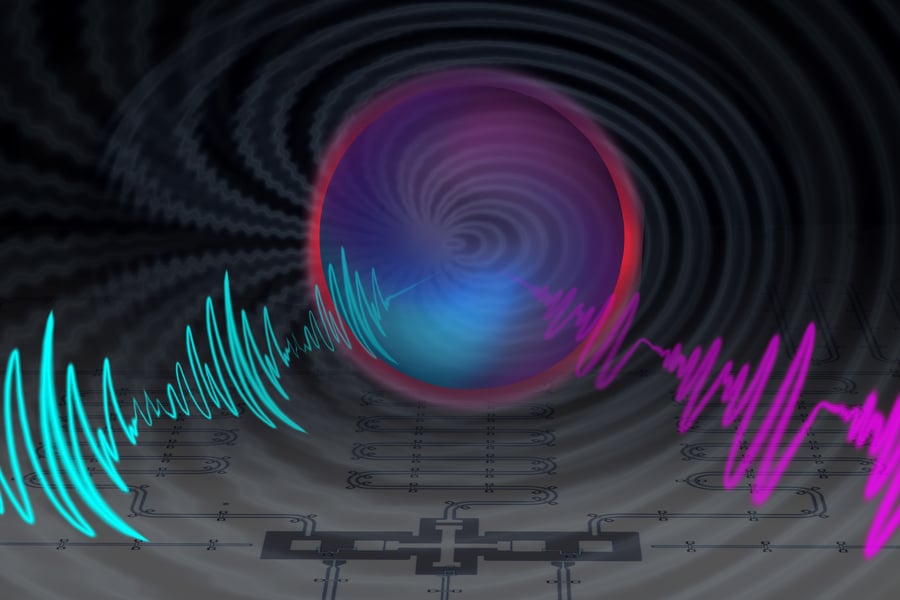Quantum computing promises to solve complex problems exponentially faster than a classical computer, by using the principles of quantum mechanics to encode and manipulate information in quantum bits (qubits).


Caption:In an artist’s impression of a recent MIT experiment, a central sphere represents a qubit, which is irradiated by two control signals: charge (blue) and flux (purple). These control signals are designed such that their combination creates a circularly-polarized microwave that is immune to counter-rotating effects. The signals are made of a repeating waveform, representing the similarity of control pulses resulting from the authors’ commensurate driving technique. Image credit: Sampson Wilcox/Research Laboratory of Electronics
Qubits are the building blocks of a quantum computer. One challenge to scaling, however, is that qubits are highly sensitive to background noise and control imperfections, which introduce errors into the quantum operations and ultimately limit the complexity and duration of a quantum algorithm. To improve the situation, MIT researchers and researchers worldwide have continually focused on improving qubit performance.
In new work, using a superconducting qubit called fluxonium, MIT researchers in the Department of Physics, the Research Laboratory of Electronics (RLE), and the Department of Electrical Engineering and Computer Science (EECS) developed two new control techniques to achieve a world-record single-qubit fidelity of 99.998 percent. This result complements then-MIT researcher Leon Ding’s demonstration last year of a 99.92 percent two-qubit gate fidelity.
The paper’s senior authors are David Rower PhD ’24, a recent physics postdoc in MIT’s Engineering Quantum Systems (EQuS) group and now a research scientist at the Google Quantum AI laboratory; Leon Ding PhD ’23 from EQuS, now leading the Calibration team at Atlantic Quantum; and William D. Oliver, the Henry Ellis Warren Professor of EECS and professor of physics, leader of EQuS, director of the Center for Quantum Engineering, and RLE associate director. The paper recently appeared in the journal PRX Quantum.
Decoherence and counter-rotating errors
A major challenge with quantum computation is decoherence, a process by which qubits lose their quantum information. For platforms such as superconducting qubits, decoherence stands in the way of realizing higher-fidelity quantum gates.
Quantum computers need to achieve high gate fidelities in order to implement sustained computation through protocols like quantum error correction. The higher the gate fidelity, the easier it is to realize practical quantum computing.
MIT researchers are developing techniques to make quantum gates, the basic operations of a quantum computer, as fast as possible in order to reduce the impact of decoherence. However, as gates get faster, another type of error, arising from counter-rotating dynamics, can be introduced because of the way qubits are controlled using electromagnetic waves.
Single-qubit gates are usually implemented with a resonant pulse, which induces Rabi oscillations between the qubit states. When the pulses are too fast, however, “Rabi gates” are not so consistent, due to unwanted errors from counter-rotating effects. The faster the gate, the more the counter-rotating error is manifest. For low-frequency qubits such as fluxonium, counter-rotating errors limit the fidelity of fast gates.
“Getting rid of these errors was a fun challenge for us,” says Rower. “Initially, Leon had the idea to utilize circularly polarized microwave drives, analogous to circularly polarized light, but realized by controlling the relative phase of charge and flux drives of a superconducting qubit. Such a circularly polarized drive would ideally be immune to counter-rotating errors.”
While Ding’s idea worked immediately, the fidelities achieved with circularly polarized drives were not as high as expected from coherence measurements.
“Eventually, we stumbled on a beautifully simple idea,” says Rower. “If we applied pulses at exactly the right times, we should be able to make counter-rotating errors consistent from pulse-to-pulse. This would make the counter-rotating errors correctable. Even better, they would be automatically accounted for with our usual Rabi gate calibrations!”
They called this idea “commensurate pulses,” since the pulses needed to be applied at times commensurate with intervals determined by the qubit frequency through its inverse, the time period. Commensurate pulses are defined simply by timing constraints and can be applied to a single linear qubit drive. In contrast, circularly polarized microwaves require two drives and some extra calibration.
“I had much fun developing the commensurate technique,” says Rower. “It was simple, we understood why it worked so well, and it should be portable to any qubit suffering from counter-rotating errors!”
“This project makes it clear that counter-rotating errors can be dealt with easily. This is a wonderful thing for low-frequency qubits such as fluxonium, which are looking more and more promising for quantum computing.”
Fluxonium’s promise
Fluxonium is a type of superconducting qubit made up of a capacitor and Josephson junction; unlike transmon qubits, however, fluxonium also includes a large “superinductor,” which by design helps protect the qubit from environmental noise. This results in performing logical operations, or gates, with greater accuracy.
Despite having higher coherence, however, fluxonium has a lower qubit frequency that is generally associated with proportionally longer gates.
“Here, we’ve demonstrated a gate that is among the fastest and highest-fidelity across all superconducting qubits,” says Ding. “Our experiments really show that fluxonium is a qubit that supports both interesting physical explorations and also absolutely delivers in terms of engineering performance.”
With further research, they hope to reveal new limitations and yield even faster and higher-fidelity gates.
“Counter-rotating dynamics have been understudied in the context of superconducting quantum computing because of how well the rotating-wave approximation holds in common scenarios,” says Ding. “Our paper shows how to precisely calibrate fast, low-frequency gates where the rotating-wave approximation does not hold.”
Physics and engineering team up
“This is a wonderful example of the type of work we like to do in EQuS, because it leverages fundamental concepts in both physics and electrical engineering to achieve a better outcome,” says Oliver. “It builds on our earlier work with non-adiabatic qubit control, applies it to a new qubit — fluxonium — and makes a beautiful connection with counter-rotating dynamics.”
The science and engineering teams enabled the high fidelity in two ways. First, the team demonstrated “commensurate” (synchronous) non-adiabatic control, which goes beyond the standard “rotating wave approximation” of standard Rabi approaches. This leverages ideas that won the 2023 Nobel Prize in Physics for ultrafast “attosecond” pulses of light.
Secondly, they demonstrated it using an analog to circularly polarized light. Rather than a physical electromagnetic field with a rotating polarization vector in real x-y space, they realized a synthetic version of circularly polarized light using the qubit’s x-y space, which in this case corresponds to its magnetic flux and electric charge.
The combination of a new take on an existing qubit design (fluxonium) and the application of advanced control methods applied to an understanding of the underlying physics enabled this result.
Platform-independent and requiring no additional calibration overhead, this work establishes straightforward strategies for mitigating counter-rotating effects from strong drives in circuit quantum electrodynamics and other platforms, which the researchers expect to be helpful in the effort to realize high-fidelity control for fault-tolerant quantum computing.
Adds Oliver, “With the recent announcement of Google’s Willow quantum chip that demonstrated quantum error correction beyond threshold for the first time, this is a timely result, as we have pushed performance even higher. Higher-performant qubits will lead to lower overhead requirements for implementing error correction.”
Written by Sandi Miller
Source: Massachusetts Institute of Technology




